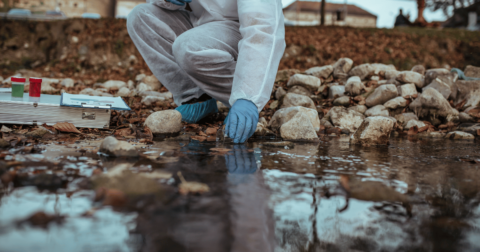Explainer
How Overconsumption Affects the Environment and Health, Explained
Climate•12 min read
Reported
Ohio Department of Natural Resources has confirmed 3,500 dead fish in waterways as well as deceased hellbender salamanders, an endangered species in the state.


Words by John McCracken, Investigate Midwest
‘This is absurd’: Train cars that derailed in Ohio were labeled non-hazardous
Nearly two weeks after a train carrying hazardous chemicals derailed in rural Ohio, questions still linger about the lasting effects of the incident and the speed at which residents were returned to their homes.
Around 9 p.m. on February 3, a train operated by Norfolk Southern Railway derailed in East Palestine, Ohio, located on the border of Pennsylvania and roughly an hour from Pittsburgh.
Among the chemicals the freight was carrying, five cars contained vinyl chloride, a colorless gas that is linked to various cancers and is used in a variety of plastic products and manufacturing. In the initial days after the derailment, temperatures rose in the cars holding the vinyl chloride and officials at both the railroad company and the U.S. Environmental Protection Agency, or EPA, ordered that residents evacuate East Palestine.
Speaking at a press conference on Tuesday, Republican Governor Mike DeWine said he learned that the train cars were marked as non-hazardous, and thus officials weren’t notified that the train would be crossing through the state.
The governor called on Congress to look into the regulations that would allow a train carrying multiple cars with hazardous substances to be labeled non-hazardous.
“Frankly, if this is true, this is absurd and we need to look at this,” DeWine said. “We should know when we have trains carrying hazardous materials that are going through the state of Ohio.”
DeWine also said that prior to the decision to release the chemicals, he was presented with “two bad options.”
One was to do nothing and risk that a train car full of vinyl chloride would explode, which would have been “catastrophic,” resulting in shrapnel flying out in a one-mile radius. The second option won, and officials conducted a controlled burn of the chemicals.
Skepticism over the decision to return residents back to their homes has grown since the initial burn. A local environmental group is calling on DeWine to declare an emergency to receive additional federal support.
Norfolk Southern spokesperson Connor Spielmaker said the decision to conduct a controlled burn was reached as a group, which echoed DeWine’s recent update.
“Norfolk Southern hazardous material personnel were on-scene and coordinating with local first responders immediately following the derailment,” Spielmaker told Grist.
According to the EPA, contaminated soil at the site was covered to rebuild the rail line.
The release of hazardous chemicals barrelling through rural Ohio late in the night have caused a variety of concerns. Residents have reported headaches, dizziness, and fevers since returning home on February 8 as they continue to conduct voluntary home air and water tests.
“We basically nuked a town with chemicals so we could get a railroad open,” Sil Caggiano, a hazardous materials specialist, told WKBN.
The derailment did not result in any immediate human fatalities, but residents are now reporting deaths of pets, chickens, and foxes. Given the spill’s proximity to the Ohio River Basin, which touches 14 states in the region, concerns of surrounding pollution have popped up in middle Tennessee, Kentucky, Cincinnati, Ohio, and West Virginia.
In addition to the vinyl chloride, various other chemicals were spilled, leading to concern for water, soil, and groundwater pollution.
According to the manifest of contents inside the railcars provided to the EPA from Norfolk Southern, undisclosed amounts of butyl acrylate, a hazardous chemical known to cause skin irritation that is used in plastic production, and propylene glycol, a generally non-toxic chemical used in food packaging, spilled during the derailment. Additionally, undisclosed amounts of ethylhexyl acrylate, a carcinogen linked to aquatic death, and petroleum spilled at the site.
On Tuesday, Ohio environmental regulators confirmed that butyl acrylate was found in nearby waterways and that the spill did make its way to the Ohio River.
Tiffani Kavalec, division chief of the Ohio Environmental Protection Agency, said the state agency is monitoring a moving plume of contaminants in the Ohio River. But, she said, there is no concern that the chemicals will make their way into drinking water systems connected to the Ohio River due to the size of the river and its ability to self-filter.
Closer to the derailment site, however, officials with the Ohio EPA and the state’s Department of Public Health urged those on private drinking water to drink bottled water as agencies continue to monitor groundwater.
The Ohio Department of Natural Resources confirmed 3,500 dead fish in waterways as well as deceased hellbender salamanders, an endangered species in the state.
In a statement to Grist, Debra Shore, Ohio’s regional administrator for the federal EPA, said the agency has issued a letter to the rail company that outlines Norfolk Southern’s potential liability caused by the release of hazardous chemicals.
This article originally appeared in Grist here.
Grist is a nonprofit, independent media organization dedicated to telling stories of climate solutions and a just future. Learn more at Grist.org